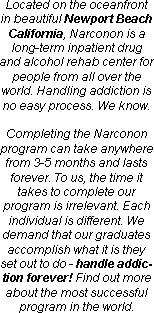
|
Navigate |
| Home |
| Kirstie Alley |
| Our 30th Anniversary |
| Never Turning Back |
| Narconon Endorsements |
| |
|
|
| |
|
|
| |
|
Facts About Drugs |
| FAQ About Ambien |
| FAQ About Ativan |
| FAQ About Cocaine |
| FAQ About Codeine |
| FAQ About Crack |
| FAQ About Darvocet |
| FAQ About Dexedrine |
| FAQ About Demerol |
| FAQ About Dilaudid |
| FAQ About Ecstasy |
| FAQ About GHB |
| FAQ About Heroin |
| FAQ About Hydrocodone |
| FAQ About Ketamine |
| FAQ About Lortab |
| FAQ About LSD |
| FAQ About Marijuana |
| FAQ About Morphine |
| FAQ About Meth |
| FAQ About Methadone |
| FAQ About Opiates |
| FAQ About Opium |
| FAQ About Oxycontin |
| FAQ About Percocet |
| FAQ About Percodan |
| FAQ About Ritalin |
| FAQ About Rohypnol |
| FAQ About Ultram |
| FAQ About Valium |
| FAQ About Vicodin |
| FAQ About Xanax |
  |
|
Resources |

|


 Print this article |  Send this article to a friend |  Add to Favorites |
About
Addiction
Addictive
drugs activate the brain’s reward systems. The promise of reward is very
intense, causing the individual to crave the drug and to focus his or her activities
around taking the drug. The ability of addictive drugs to strongly activate brain
reward mechanisms and their ability to chemically alter the normal functioning
of these systems can produce an addiction. Drugs also reduce a person’s level
of consciousness, harming the ability to think or be fully aware of present surroundings.
The Cycle of Addiction
What Is A Drug?
In medical terms, a drug is any substance that when taken into a living organism may modify one or more of its functions. Drugs can provide temporary relief from unhealthy symptoms and/or permanently supply the body with a necessary substance the body can no longer make. Some drugs produce unwanted side affects. Some drugs lead to an unhealthy dependency that has both physiological and behavioral roots.
Why People Use Drugs
No one wants to be a drug addict or alcoholic, but this doesn’t stop people from getting addicted. The most commonly asked question is simply - how? How could my son, daughter, father, sister, or brother become a liar, a thief, someone who cannot be trusted? How could this happen? And why won’t they stop?
The first thing you must understand about addiction is that alcohol and addictive drugs are basically painkillers. They chemically kill physical or emotional pain and alter the mind’s perception of reality. They make people numb.
For drugs to be attractive to a person there must first be some underlying unhappiness, sense of hopelessness, or physical pain.
Drug Addiction Follows A Cycle Like This:
The life cycle of addiction begins with a problem, discomfort or some form of
emotional or physical pain a person is experiencing. They find this very difficult
to deal with.
We start off with an individual who, like most people
in our society, is basically good. This person encounters a problem or discomfort
that they do not know how to resolve or cannot confront. This could include problems
such as difficulty “fitting in” as a child or teenager, anxiety due
to peer pressure or work expectations, identity problems or divorce as an adult.
It can also include physical discomfort, such as an injury or chronic pain. The
person experiencing the discomfort has a real problem. He feels his present situation
is unendurable, yet sees no good solution to the problem.
Everyone has experienced this in life to a greater or lesser degree. The difference between an addict and the non-addict is that the addict chooses drugs or alcohol as a solution to the unwanted problem or discomfort.
The Addiction Progresses…
Analogous to an adolescent child in his first love affair, the use of drugs or
alcohol becomes obsessive. The addicted person is trapped. Whatever problem he
was initially trying to solve by using drugs or alcohol fades from memory. At
this point, all he can think about is getting and using drugs. He loses the ability
to control his usage and disregards the horrible consequences of his actions.
Alcohol And Drug Tolerance
In addition to the mental stress created by his unethical behavior, the addict’s body has also adapted to the presence of the drugs. He will experience an overwhelming obsession with getting and using his drugs, and will do anything to avoid the pain of withdrawing from them. This is when the newly-created addict begins to experience drug cravings.
He now seeks drugs both for the reward of the “pleasure” they give him,
and also to avoid the mental and physical horrors of withdrawal. Ironically, the
addict’s ability to get “high” from the alcohol or drug gradually
decreases as his body adapts to the presence of foreign chemicals. He must take
more and more, not just to get an effect but often just to function at all.
At this point, the addict is stuck in a vicious dwindling spiral. The drugs he abuses have changed him both physically and mentally. He has crossed an invisible and intangible line. He is now a drug addict or alcoholic.
This person tries drugs or alcohol. The drugs APPEAR to solve his problem. He feels better. Because he now SEEMS better able to deal with life, the drugs become valuable to him. The person looks on drugs or alcohol as a cure for unwanted feelings. The painkilling effects of drugs or alcohol become a solution to their discomfort. Inadvertently the drug or alcohol now becomes valuable because it helped them feel better. This release is the main reason a person uses drugs or drinks a second or third time. It is just a matter of time before he becomes fully addicted and loses the ability to control his drug use. Drug addiction, then, results from excessive or continued use of physiologically habit-forming drugs in an attempt to resolve the underlying symptoms of discomfort or unhappiness.
How Drugs Affect Behavior
The addict will now attempt to withhold the fact of his drug use from friends and family members. He will begin to suffer the effects of his own dishonesty and guilt. He may become withdrawn and difficult to reason with. He may behave strangely.
The more he uses drugs and alcohol, the guiltier he will feel, and the more depressed he will become. He will sacrifice his personal integrity, his relationships with friends and family, his job, his savings, and anything else he may have in an attempt to get more drugs. The drugs are now the most important things in his life. His relationships and job performance will go drastically downhill.
There is such a thing as a “drug personality.” It is artificial and
is created by drugs. Drugs can change the attitude of a person from his original
personality to one secretly harboring hostilities and hatreds he does not permit
to show on the surface.
This establishes a link between drugs and increasing
difficulties with crime, production and the modern breakdown of social and industrial
culture.
The drug personality includes such characteristics as:
|
When a person drinks or uses drugs over a period of time, the body becomes unable to completely eliminate them all. Drugs and alcohol are broken down in the liver. These metabolites, (the substances the body converts the drugs or alcohol into) although removed rapidly from the blood stream, become trapped in the fatty tissues. There are various types of tissues that are high in fat content, the one thing in common – and the problem that needs to be addressed is that these drug residues remain for years. Tissues in our bodies that are high in fats are turned over very slowly. When they are turned over, the stored drug metabolites are released into the blood stream and reactivate the same brain centers as if the person actually took the drug. The former addict now experiences a drug restimulation (or “flashback”) and drug craving. This is common in the months after an addict quits and can continue to occur for years, even decades.
The Cycle Of Quitting, Withdrawal, Craving And Relapse When the addict initially tries to quit, cells in the brain that have become used to large amounts of these metabolites are now forced to deal with much decreased amounts. Even as the withdrawal symptoms subside, the brain “demands” that the addict give it more of the drug. This is called drug craving. Craving is an extremely powerful urge and can cause a person to create all kinds of “reasons” they should begin using drugs or drinking again. He is now trapped in an endless cycle of trying to quit, craving, relapse and fear of withdrawal. Eventually, the brain cells will again become used to having lowered drug metabolites. But, because deposits of drug or alcohol metabolites release back into the bloodstream from fatty tissues for years, craving and relapse remain a cause for concern. Left unhandled, the presence of metabolites even in microscopic amounts cause the brain to react as if the addict had again actually taken the drug and can set up craving and relapse even after years of sobriety. To prevent relapse due to the above scenario the solution is the Narconon New Life Detoxification procedure.
Intervention - -How You Can Help!
An drug addict usually does not know he is out of control. He looks at his drug-using peers and his own use appears normal in comparison. He needs objective feedback on his behavior.
It was once thought that an alcoholic or other drug abuser had to "hit bottom" before help could be offered and accepted; that a drug addict could only get better if he was self-motivated to change. This has changed to the view that a skilled professional counselor can motivate an addict toward recovery. This is called intervention.
Intervention is a process that helps an addict recognize the extent of his problem. Through a non-judgmental, non-critical, systematic process, the drug addict is confronted with the impact of his alcoholism or drug use on others. The goal of intervention is for him to accept the reality of his drug addiction and to seek help.
STEPS
OF INTERVENTION
Q) If an addict is unwilling to seek help, is there any way to get him into treatment?
A) This can be a challenging situation. An addict cannot be forced to get help except under certain circumstances, such as when a violent incident results in police being called or following a medical emergency. This doesn’t mean, however, that you have to wait for a crisis to make an impact. Based on clinical experience, many treatment specialists recommend the following steps to help an addict accept treatment:
1. Stop all “rescue missions.” Family members often try to protect an addict from the results of his behavior by making excuses to others about his addiction problem and by getting him out of drug-related jams. It is important to stop all such rescue attempts immediately, so that the addict will fully experience the harmful effects of his use—and thereby become more motivated to stop.
2. Don’t enable him. Sometimes family members feel sorry for the addict or tend to avoid the addict, let him come and go as he pleases. This comes across to the addict as a reward—after all, all he wants is to be left alone. Be careful not to reward by paying his bills, bailing him out of jail, letting him stay for free, etc. This kind of reward creates out exchange and criminal behavior.
3. Time your intervention. If possible, plan to talk with the addict when he is straight, when all of you are in a calm frame of mind and when you can speak privately.
4. Be specific. Tell the family member that you are concerned about his addiction and want to be supportive in getting help. Back up your concern with examples of the ways in which his drug use has caused problems for you, including any recent incidents.
5. State the consequences. Tell the family member that until he gets help, you will carry out consequences—not to punish the addict, but to protect yourself from the harmful effects of the addiction. These may range from refusing to be with the person when they are under the influence, to having them move out of the house. Do NOT make any threats you are not prepared to carry out. The basic intention is to make the addict’s life more uncomfortable if he continues using drugs than it would be for him to get help.
6. Find strength in numbers with the help of family members, relatives and friends to confront the addict as a group but choose one person to be the initial spokesperson. It will be much more effective for the others to simply be there nodding their heads, than it would be for everyone to talk at once and “gang up on him.” Remember the idea is to make it safe for him to come clean and seek help.
7.
Listen. If during your intervention the addict begins asking questions like; Where
would I have to go? For how long? This is a sign that he is reaching for help.
Do not directly answer these questions. Instead have him call in to talk to a
professional. Support him. Don’t wait. Once you’ve gotten his agreement,
get him admitted immediately. Therefore, you should have a bag packed for him,
any travel arrangements made and prior acceptance into a program.
Top
of Page

comment corner
 |
| drug rehabilitation saving taxpayers |
California taxpayers are saving more money than expected due to ... |
 |
| Study: Marijuana Causes Lung Damage |
New research finds that smoking three or four marijuana cigarettes ... |
 |
| Thanks to Online Pharmacies, Addiction Can Be Just a Click Away |
WASHINGTON -- Kelly Knable, a 34-year-old mother of three from ... |
 |
| Balancing pain and drug addiction |
Over the past two decades, two conflicting medical ideas have ... |
 |
| Clean break |
... |
 |
| State officials create prescription drug abuse task force |
TALLAHASSEE, Fla. -- State officials on Friday announced the creation ... |
 |
| Florida system often fails to catch Medicaid abuse at source |
FORT LAUDERDALE, Fla. - (KRT) - The victim's skin was ... |
 |
| Marijuana's rising threat: For more kids, use turns into addiction |
John Brown experimented with marijuana at age 10, and it ... |
 |
| Student gets state prison term for selling marijuana |
EASTON -- David Messina had his whole life ahead of ... |
 |
| Man charged in cocaine case forfeits $585,000 |
An Iowa truck driver arrested by Kentucky Vehicle Enforcement officers ... |
 |
| Cocaine Curtails Body's Ability to Cool Off |
In addition to triggering life-threatening cardiovascular episodes, cocaine can be ... |
 |
| Science for Cops |
I admit it: I'm a Law & Order fan. ... |
 |
| New Gene Therapy Could Help Quell Alcoholic Cravings |
One prevailing view of addiction holds that alcohol and other ... |
 |
| One Dose of Cocaine Primes the Brain for Addiction |
It isn't a myth: one dose of cocaine is all ... |
 |
| Marijuana Firmly Linked to Infertility |
Scientists from the University of Buffalo have smoked out what ... |
 |
| Moderate Alcohol Consumption Clouds Brain's Ability to Detect Mistakes |
It's common knowledge that a brain on booze doesn't function ... |
|
Narconon Pictures |
|
   |
|